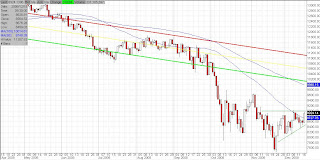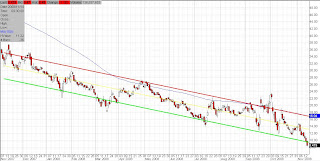Gary the chimp is doing a lot better than we are. He's up 5.2% as of the close today, compared with a loss of 8.0% for the S&P500 index. It's been 2 months since Gary chose his portfolio by throwing darts at 5 uptrending charts and 5 downtrending charts. Over the same time period, Buffett's Berkshire Hathaway is down 19.4%, Icahn's MOT is down 18.6%, Kerkorian's MGM is down 26.1%, and Adelson's LVS is down 63%.
Gary's performance continues to improve as time goes by because more and more of his charts are showing their true colors. The beginning was rocky for his portfolio, as many of the stocks were bought at short term inopportune times. But now with two months of momentum, Gary's underlying thesis that an object in motion remains in motion is being proven correct.
If we can prove (in real time) this simple concept on a little blog like this, then the burning question is why don't the pros know this? Buffett bought GS at 120 or so, and GE at 25. Gary would have shorted both of those charts.
Speaking of GS, it looks as if it is breaking through the top of its ascending triangle, which bodes well for the market as a whole.
We'll have to see how long Gary continues to outperform the market. His approach likely has a shelf life, as no chart goes in one direction for too long without reversing. The chart above is of EBS, one of Gary's longs. Even though his performance is impressive (leaving his more intelligent human peers in the dust), it must be understood that his performance will always be better relative to the market during bad times. In good times, Gary will still profit, but will underperform the market. He is most likely to make about 1% to 2% a month over the long run, regardless of what the indexes do. His approach is well suited for those who chose to accept a somewhat muted return during bull markets in return for far less anxious times during bear markets. We're hoping Gary can continue to maintain his current 2.5% monthly profit, which would give him a 30% yearly gain. It sounds too ambitious, considering this would mean his account would triple in value every 3 years.
Regardless of whether he makes 10% or 30% a year, your money would be far safer invested with this chimp than with Bernard Madoff. In a nutshell, this one statement sums up the reality of Wall Street, the scam that is the backbone of our financial system. Last we heard, Madoff may get the most severe punishment the SEC can give him... a very hard slap on the wrist accompanied by a $75 fine. He may also have to apologize to those he scammed. Surely this severe treatment will send a message to future scammers and make Wall Street a safer place for our grandchildren to invest their life savings.
















































